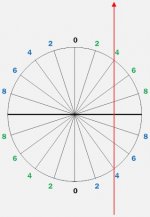PKM said:Patrick, regarding your two diagrams, the idea is that the numbers never change for a given object ball position, regardless of cue ball position.
Yes, the way the system is taught the numerical "lineup" describes the OB's position in relation to the pocket (for instance, if the OB is 45 degrees from the pocket, the "shot number" is 4.5 no matter what the cut angle is between the CB and OB).
My alternate way the numerical lineup describes the CB/OB alignment for the shot (for instance, a 45 degree cut is always shot number 4.5 no matter what angle the OB is from the pocket).
Joe's way works fine; I wonder if my way might be more intuitive for some players. Maybe Joe could expand the usefulness (and market) for his system by describing both.
As for using the numbers on the closer side of the CB, I'm not sure that makes it any easier since it doesn't change the fact that you're connecting the contact point on the other side of the CB. Think about the position of the two balls at contact, essentially you're sending that opposite position on the CB to its position in the ghost ball.
[EDIT:] I'm not sure exactly what you said there, but after thinking it over I can see that reversing the numbers would only work with my alternative method (orienting the numbers so the zeroes point toward each other). But in that case the number on the visible side of the CB would line up with the actual CB contact point and the OB contact point, so it would work theoretically and might be a useful visual aid. I guess this is a potential benefit of my alternative idea.
pj
chgo
Last edited:
